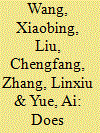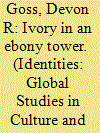|
|
|
Sort Order |
|
|
|
Items / Page
|
|
|
|
|
|
|
| Srl | Item |
| 1 |
ID:
120621


|
|
|
|
|
| Publication |
2013.
|
| Summary/Abstract |
The rapid expansion of enrollment capacity in China's colleges since the late 1990s has come at the price of high tuition hikes. China's government has put forth financial aid programs to enable poor students to access higher education. Although studies have shown that poor high school students are indeed able to attend college when their test scores are high enough (that is, few are unable to attend when they are qualified to attend), the literature has not explored whether poor students have sufficient amounts of aid to thrive in college.
Using findings from a randomized controlled trial, this study evaluates the impact of providing full scholarships to students from poor rural areas (henceforth treatment students) on student stress levels, self-esteem/self-efficacy, and participation in activities in four first-tier colleges. To do so, we compare outcomes of the treatment students with students who were not given full scholarships by the project (and were left to search for scholarships and other sources of financial aid from the university system itself-the control students). The project was run among the 200 poorest first-year students in four first-tier colleges in inland China. Somewhat surprisingly, we find that treatment students (those receiving full scholarships from the project) were only slightly more successful in obtaining financial aid than control students. This suggests that control students (those who did not receive full scholarships from the project) were still able to access comparable levels of financial aid. Most importantly, scholarship recipients were statistically identical in outcome to control students in terms of stress, self-esteem, and participation in college activities, suggesting that poor students (who are dependent on aid from the university system) currently are able to access sufficient levels of financial aid, are able to take advantage of the activities offered at college, and do not shoulder heavy financial or psychological costs.
We find, therefore, that efforts of the government to alleviate the financial burden of college on the poor have been relatively successful in first-tier colleges. Because of this, foundations and individuals may decide that if they want to improve human welfare, giving additional scholarships at high tier colleges may be having little effect.
|
|
|
|
|
|
|
|
|
|
|
|
|
|
|
|
| 2 |
ID:
112717


|
|
|
|
|
| Publication |
2012.
|
| Summary/Abstract |
China has recently undergone a series of reforms on higher education aimed at raising the level of human capital. However, relatively little is known about returns to higher education (i.e. college premium) and how it varies across population in China over time. In this paper, we contribute to the literature by examining college premium in urban China during the period of 1995-2002. We also explore the differences in college premium by gender and by sector. To isolate the causal effects of college education, we employ a novel instrumental variable approach based on heteroskedasticity in college decision to circumvent potential endogeneity and measurement error problems. Our results imply a much larger college premium and a greater growth in the college premium relative to their OLS counterparts, consistent with the general literature on returns to education. More interestingly and starkly contrasting to the existing studies using OLS in the Chinese context, our results imply that (1) the college premium is larger for women than for men in the early stage of economic reforms, but the difference decreases and becomes statistically insignificant over time; (2) the college premium is larger for workers in the state-owned enterprises than that in the non-state-owned enterprises during the early stage of economic reforms; this gap is, however, reversed in the later stage. We discuss potential reasons for these results.
|
|
|
|
|
|
|
|
|
|
|
|
|
|
|
|
| 3 |
ID:
092556


|
|
|
|
|
| Publication |
2009.
|
| Summary/Abstract |
Compared to the popular vote, the Electoral College magnifies the perception of the winner's margin of victory. In this analysis, a method of quantifying the magnitude of the advantage given to the winner due to the Electoral College's two electoral vote add-on and winner-take-all methodologies is presented. Using the electoral vote distribution that was present in the 2000 U.S. presidential election, we analyzed one million random two-candidate simulated elections. The results show that the net effect of the Electoral College is to give the winning candidate an average 29.45 electoral vote advantage per election due to the winner-take-all methodology. This winner's advantage includes an average 0.42 electoral vote advantage given to the winner per election due to the two electoral vote add-on.
|
|
|
|
|
|
|
|
|
|
|
|
|
|
|
|
| 4 |
ID:
182406


|
|
|
|
|
| Summary/Abstract |
How do white individuals establish themselves as authentic and belonging members of communities of colour? To explore this question, I examine the experiences of white students of Historically Black Colleges and Universities (HBCUs). In-depth interviews with 30 white HBCU students reveal the ways that white individuals navigate their whiteness in a space where they are deemed outsiders. Specifically, I demonstrate that white HBCU students use three strategies to differentiate themselves from whiteness writ large and establish belonging with this black community: acknowledging whiteness, wherein whites portray themselves as recognising white privilege; mitigating whiteness, wherein whites aim to balance the desire to participate in and preserve black spaces; and resisting whiteness, in which whites aim to dissociate from whiteness altogether.
|
|
|
|
|
|
|
|
|
|
|
|
|
|
|
|
|
|
|
|
|